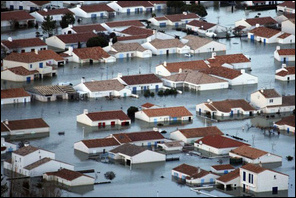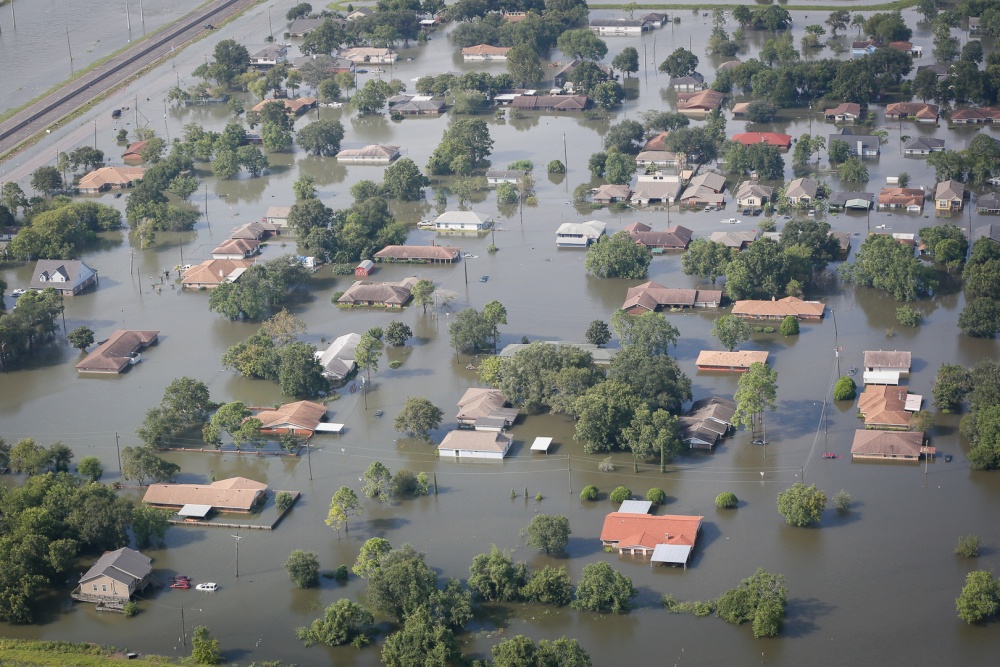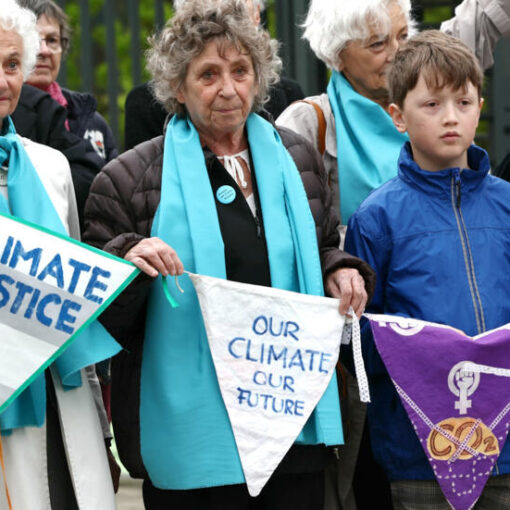
Jessica Anne Wentz
Associate Director and Postdoctoral Fellow
In the early morning of February 28, 2010, storm Xynthia hit the French Atlantic coast, overwhelming coastal defenses and flooding over 50,000 hectares of land. The storm caused over one billion euros of damage and 47 fatalities in the Vendée Department of France.[1] Over half of these fatalities occurred in the neighboring villages of La Faute-sur-Mer and L’Aiguillon-sur-Mer, where rapidly rising flood waters trapped hundreds of residents in their homes and killed 29 people. The next day, French President Nicolas Sarkozy visited the villages and announced plans to investigate the causes of the disaster: “We have to find out how families in France in the 21st century can be surprised in their sleep and drowned in their own houses,” Sarkozy said, “we have to shed light as urgently as possible on this unacceptable and incomprehensible drama.”[2]
The investigation uncovered a number of alarming details about the physical vulnerability of France’s coastal infrastructure, the inadequacies of the country’s spatial planning policies, and serious problems with national emergency notification and response procedures. But the most egregious findings related to the conduct of local public officials who encouraged residential development in the areas that were hit hardest by the flood. French authorities discovered evidence that the mayor of La Faute-sur-Mer, René Marratier, and his deputy, Françoise Babin, had overseen the construction of single-story homes in an area known as “the deadly bowl” due to extreme flood risk, and that they had failed to take adequate precautions to protect the houses from flooding or warn the residents of the flood risk.[3] In addition, the mayor and his staff failed to issue adequate warnings or evacuation orders when storm Xynthia made landfall. The investigating authorities also found evidence of negligent and wrongful conduct by Françoise Babin’s son, Philippe Babin, a real estate agent who was responsible for maintaining and monitoring the local dike, and Patrick Maslin, a construction company manager who also served as a municipal counselor. All four individuals were charged with manslaughter for their contribution to the drowning deaths in La Faute-sur-Mer and L’Aiguillon-sur-Mer that night.
Last December, the criminal court of Sables d’Olonne reached a verdict on the charges against René Marratier, Françoise Babin and Philippe Babin. All three defendants were convicted of manslaughter. The court found that the Mayor and his assistant were fully aware of the flood risks but had deliberately concealed these to avoid hindering real estate development in the area, thus breaching their “duty to protect and safeguard the population.”[4] The court also found that Marratier had intentionally obstructed the implementation of a Flood Risks Prevention Plan for this same reason. Finally, the court noted that the defendants had “unacceptable personal motives” for issuing the permits, since they had personally profited from the real estate boom. However, the case was ultimately decided on a theory of negligence, not criminal intent. Marratier was sentenced to 4 years in prison and Françoise Babin was sentenced to 2 years. The third defendant, Philippe Babin, received an 18-month sentence for failing to maintain and monitor the dikes.
Some commentators have suggested that the outcome of the storm Xynthia case is exceptional, because the deaths caused by a natural disaster are traditionally viewed as “acts of God” or “acts of nature” beyond human control. But the legal basis of the case is not unique, since many jurisdictions recognize criminal liability for grossly negligent or reckless conduct resulting in death. The decision is also part of a growing body of case law in France and other countries addressing the liability of individuals and corporations for the consequences of extreme weather events. These cases share a common premise: government officials and private parties may be held liable for deaths and other damages associated with natural disasters when those damages are a direct and foreseeable consequence of their intentional or negligent conduct. However, because this is an emerging area of law, courts are still grappling with the precise legal standards for imposing liability in their respective jurisdictions. This has led to uncertainty for litigants as well as inconsistent case outcomes.
In the U.S., for example, the Fifth Circuit Court of Appeals issued a 2012 decision holding the Army Corps of Engineers liable for flood damage during Hurricane Katrina, but the same three-judge panel reversed itself during a bench review just six months later.[5] In another case involving Hurricane Katrina damages, a jury held that the government of Jefferson Parish and the former Parish President had been negligent in deciding to evacuate pump operators before the hurricane but that this negligence had not caused the widespread flooding in the Parish. The plaintiffs in that case have since filed an appeal to challenge what they view as an inconsistent verdict.[6]
The European Court of Human Rights has also adjudicated cases involving government liability for extreme weather events: Kolyadenko v. Russia and Budayeva v. Russia. In both cases, the Court held that the government of Russia had violated its obligations under the European Convention on Human Rights by failing to prevent the foreseeable consequences of extreme weather events (flooding and mudslides). Specifically, the court found that the Russian government did not have any framework for risk assessment, implementation of land use plans, disaster management or government supervision. The court also highlighted the importance of providing legal redress procedures for the persons harmed by those events, noting that the Convention required an independent and impartial investigation and an opportunity for an adequate remedy. The Court even went so far as to suggest that criminal liability may be a necessary component of the legal remedy that states must provide: “the fact that those responsible for endangering life were not charged with a criminal offence or prosecuted may amount to a violation of Article 2, irrespective of any other types of remedy which individuals may exercise on their own initiative.”[7]
Public officials and private actors have thus been put on notice that, at least in certain jurisdictions and under certain circumstances, they could incur civil and even criminal liability for negligent or reckless conduct that contributes to death or damage during an extreme weather event. Moreover, the number of claims arising in this context will likely increase as climate change influences the predictability, severity and frequency of natural hazards. While the courts continue to refine the legal standards for adjudicating these cases, municipalities and other potential defendants can take proactive measures to avoid liability. At minimum, municipal officials and other government actors should: (1) integrate the best available science about future weather events and climate change into decisions about spatial planning, public works projects, building code requirements, hazard preparedness activities, and emergency response procedures; (2) identify foreseeable risks and either implement measures to mitigate those risks or provide a reasonable justification for why mitigation is not warranted (i.e., the cost would outweigh the benefits); and (3) inform the public of the risks that have been identified as well as the rationale for specific decisions in light of those risks. Similarly, private construction companies and developers should attempt to identify any foreseeable risks and communicate these to the public and appropriate government authorities.
[1] Bas Kolen et al., Learning from French Experiences with Storm Xynthia: Damages After a Flood (Ministerie van Verkeer en Waterstaat, Netherlands 2010).
[2] Guillaume Frouin, Sarkozy Seeks Answers Over French Flood Damage, Reuters, March 1, 2010.
[3] The area where the houses were constructed is situated in a polder approximately 2 meters below sea level.
[4] Cour d’appel de Poitiers, Tribunal de grande instance des Sables-d’Olonne, Jugement Correctionnel du 12 décembre 2014, at 180 (“Pour des mobiles personnels inacceptables, les prévenus ont violé leur obligation de protection et de sauvegarde de la population, ont mis des vies en danger”).
[5] In re Katrina Canal Breaches Litigation, 696 F.3d 436 (5th Cir. 2013) (withdrawing the court’s previous decision, F.3d 19673 F.3d 381 (5th Cir. 2012)). For more information about the legal basis of the initial decision, see Michael B. Gerrard, Hurricane Katrina Decision Highlights Liability for Decaying Infrastructure, 247(90) New York Law Journal (May 10, 2012).
[6] Chad Calder, Lawyers Plan to Appeal Verdict in Jefferson Flooding Lawsuit, The New Orleans Advocate, Feb. 12, 2014.
[7] Kolyadenko and Others v. Russia, Eur. Ct. H.R., ¶190 (Feb. 28, 2012).



